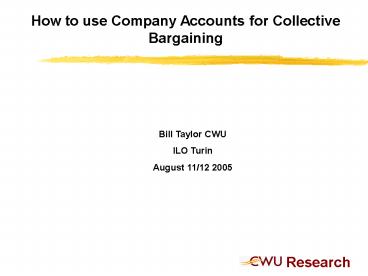How to use Company Accounts for Collective Bargaining PowerPoint PPT Presentation
1 / 14
Title: How to use Company Accounts for Collective Bargaining
1
How to use Company Accounts for Collective
Bargaining
Bill Taylor CWU ILO Turin August 11/12 2005
2
Why look at company accounts?
- Helps us to
- Build a true picture of the company
- Manage our expectations
- Build a realistic case for a pay claim
- Gives greater bargaining strength
3
What company accounts tell us
- Help us assess whether a company is
- Profitable
- Being run efficiently
- Likely to grow in the future
- Financially stable
4
Reading Annual Accounts
- Directors report
- Directors remuneration
- Ownership
- Subsidiaries
- Auditors Report
- Profit and Loss Account
- Balance Sheet
- Notes to the Accounts
5
- Profit and Loss Account
- Shows how a companys profit was reached over a
given - Period
- Turnover (Sales)
- Operating costs
- Operating profit
- Pre-tax profit
- Dividend
- Retained profit
6
- Balance Sheet
- List of assets and liabilities what the company
owns and what it owes - Fixed assets land, buildings, equipment, brand
names - Current assets bank balances, stocks and debtors
- Current liabilities debts to be paid within one
year - Long term liabilities debts to be paid after one
year - Shareholders equity/funds
7
8
Indicators of financial stability
- Size is not everything a large company is not
always a - healthy company
- Liquidity current assets greater than current
debts - Liquidity test (current assets current
liabilities) - Solvency total assets greater than total
liabilities - Solvency test (current assets fixed assets)
all liabilities
9
Assessing wealth creation
- Value Added
- Represents net wealth produced by an enterprise
- No statutory requirement to produce value added
statements - Value added is calculated by
- Turnover cost of bought-in goods and services
- Cost of bought in goods and services can be
calculated by - Operating costs (staff costs depreciation)
10
Indicators of efficiency (productivity measures)
- Show how much each employee contributes in
financial terms - Useful to track over time
- Turnover (sales) per employee (Turnover/number
of employees) - Operating profit per employee (operating
profit/number of employees) - Value added per employee (value added/number of
employees) - Value added in relation to labour costs (value
added/wages, salaries and fringe benefits)
11
Indicators of profitability
- Profitability is a key determinant of the amount
by which an - Employer can afford to increase pay
- The following measures the ratio between turnover
and - operating costs. The lower the ratio the better.
- (operating costs depreciation)/ turnover
- The following measures the relationship between
gross operating - profit, and wealth created. The higher the ratio
the better. - (gross operating profit depreciation)/value
added
12
Indicators of Growth Potential
- Capital expenditure is the major factor in
determining the - likelihood of expansion
- Capital expenditure in relation to wealth created
- (Capital expenditure/value added)
- Relative strength of the current commitment to
capital - expenditure
- (Capital expenditure/number of employees)
- If both ratios are high, the company has good
growth prospects
13
Summary
- Company accounts important for creating a true
picture of performance - Balance sheet, profit and loss, notes to the
accounts - Financial Stability
- Efficiency/productivity
- Profitability
- Growth Potential
- Allows us to build a realistic case for a pay
claim - Gives greater bargaining strength
14
- Questions and discussion

